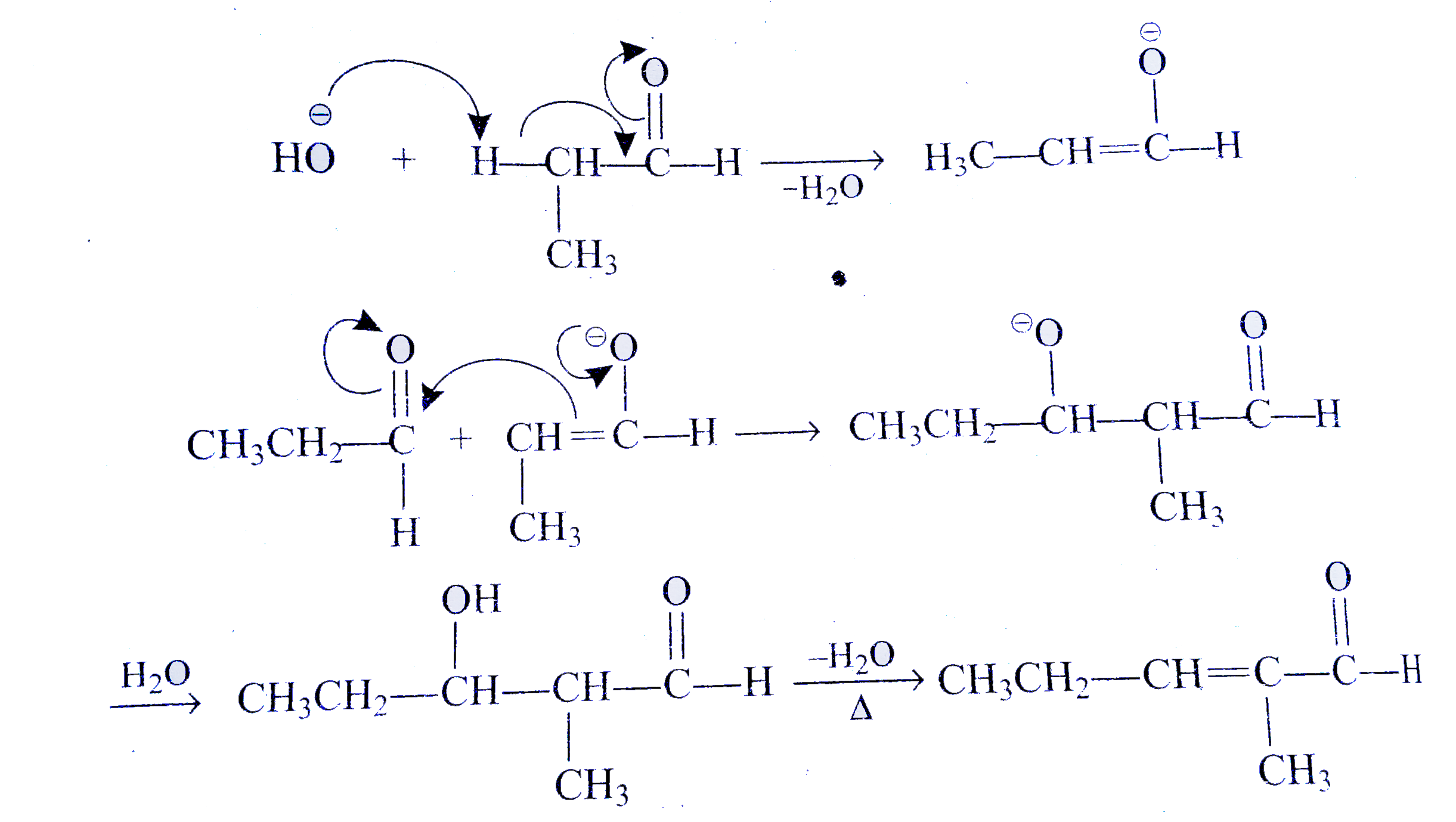The reactions of hydroxylamine with a symmetrical ketone (R2C=O) froms only one oxmie. However two isomeric oximes may be formed when an aldehyde or non-symmetical ketone takes part in the reaction. Explain.
In an oxime. The rotation about >C=N bond is restricted. In case two different atoms/group are attached to the double bonded carbon atom, geometrical isomerism is possible. For example,

Topper's Solved these Questions
- ALDEHYDES AND KETONES Book:DINESH PUBLICATIONChapter:ALDEHYDES AND KETONES Exercise:Question From Board
Explore 86 Videos
- ALDEHYDES AND KETONES Book:DINESH PUBLICATIONChapter:ALDEHYDES AND KETONES Exercise:Higher Order Thinking Skills
Explore 6 Videos
- ALDEHYDES AND KETONES Book:DINESH PUBLICATIONChapter:ALDEHYDES AND KETONES Exercise:Problem
Explore 15 Videos
- ALCOHOLS AND PHENOLSBook:DINESH PUBLICATIONChapter:ALCOHOLS AND PHENOLSExercise:Matrix
Explore 9 Videos
- ALKALI EARTH METALSBook:DINESH PUBLICATIONChapter:ALKALI EARTH METALSExercise:Unit test-12
Explore 5 Videos
Similar Questions
When semicarbazide reacts with a ketone (or aldehyde) to form semicarbazone. Only one nitrogen atom of semicarbazide acts as a nucleophile and attack the carbonyl carbon of the ketone. The product fo the reaction consequently is R2C=N−NH−CONH2 rather than R2C=NCONH−NH2. what factor account for the fact that two nitrogen atoms of semicarbazide are relatively non nucleophilic ?
View SolutionA ketone A, which undergoes halform reaction, gives compound B on reduction B on heating with sulphuric acid gives compounds C, which forms mono-ozonide D.D on hydrolysis in the presence of zinc dust gives only acetaldehyde. Identify A, B and C. Write down the reaction involved.
View Solution
Knowledge Check
The additon reaction of enol or enolate to the carbonyl function of aldehyde or ketone is known as aldol addition . The β-hydroxyaldehyde or β−hydroxyketone so obtained undergo dehydration in second step to produce a conjugated enone. The first part of reaction is an addition reaction and the second part is an elimination reaction. Carbonyl compound having α-hydrogen undergoes aldol condensation reaction .
2CH3CH2−O∣∣C−HӨOH−−→ΔCH3CH2CH=C∣CH3−O∣∣C−H

Find out product of following reaction :

X is :ACH3−CH=CH−O∣∣C−PhB CPh−O∣∣C−CH=C∣Ph−CH3DNone of these
CPh−O∣∣C−CH=C∣Ph−CH3DNone of theseThe additon reaction of enol or enolate to the carbonyl function of aldehyde or ketone is known as aldol addition . The β-hydroxyaldehyde or β−hydroxyketone so obtained undergo dehydration in second step to produce a conjugated enone. The first part of reaction is an addition reaction and the second part is an elimination reaction. Carbonyl compound having α-hydrogen undergoes aldol condensation reaction .
2CH3CH2−O∣∣C−HӨOH−−→ΔCH3CH2CH=C∣CH3−O∣∣C−H

Find out major product of following reaction :
 A
A B
B C
C D
D
The additon reaction of enol or enolate to the carbonyl function of aldehyde or ketone is known as aldol addition . The β-hydroxyaldehyde or β−hydroxyketone so obtained undergo dehydration in second step to produce a conjugated enone. The first part of reaction is an addition reaction and the second part is an elimination reaction. Carbonyl compound having α-hydrogen undergoes aldol condensation reaction .
2CH3CH2−O∣∣C−HӨOH−−→ΔCH3CH2CH=C∣CH3−O∣∣C−H

Which of the following will give aldol condensation ?A BH−O∣∣C−HC
BH−O∣∣C−HC D
D
A ketone (C4H8O) , which undergoes a haloform reaction gives compound B on reduction. B on heating with sulphuric acid gives a compound C which forms monozonide D. Don hydrolysis in presence of zinc dust gives only acetaldehyde E. Identify A, B, C, D and E. Write the reactions involved.
View SolutionConsider the possible formation of an aldehyde or ketone product when each of the ten compounds in the column on the left is treated with each of the reagents shown in the top row . Check the designated answer box if you believe an aldehyde or ketone will be formed .
Assume that the reagents may be present in excess . For each checked reaction , try to draw the structure of the major product (s) .

View SolutionThe IUPAC names of open chain aliphatic aldehdes and ketones are derived from the names of the corresponding alkanes by replacing the ending -e with -al and - one respectively. In case of aldehydes the longest carbon chain is numbered starting from the carbon of the aldehyde group while in case of ketones the numbering begins from the the end nearer to the carbonyl group. The substituents are prefixed in alphabetical order along with numberals indicating their positions one . when the aldehyde group is attached to a ring, the suffix carbaldehyde is added after the full name of the cycloalkane. The numbering of the ring carbon atoms start from the carbon atom attached to the aldehyde group. The name of the simplest aromatic aldehyde carrying the aldehyde group on a benzene ring is benzenenecarbaldehyde. However, the common name benzaldehyde is also accepted by IUPAC. Other aromatic aldehydes are hence named as substituted benzaldehydes.
Name the following compound as per IUPAC system ?
CH3−Cl∣C=CHCH−CHO
View SolutionWhich of he following statement is//are true.
(1) The reaction of methyl magnesium bromide with acetone followed by hdrolysis gives secondary also
(2) Aldehydes are more reactive than ketones.
(3) The yield of ketone, when a secondary alcohol is oxidised, is more than the yield of aldehyde when primary alcohol is oxidised by K2Cr2O7/H⊕
(4) Both aldehydes and ketones reduce Tollen's reagent.
View SolutionIn presence of excess base and exces shalogen a methyl ketone is converted first into a trihalo substituted ketone and then into a carbonylc acid . After the trihalo substituted ketone is formed hydroxide ion attacks the carboxyl carbon because the trihalo methyl ion is the group more easily expelled from the tetrahedral intermediate .The conversion of methyl ketone to a carboxylic acid is called a haloform reaction because one of the product is halofor (CHCl3) or CHI3 or CHBr3.

Which of the following compoud show haloform reaction and racemisation in OD−/D2O.
View Solution

